NavSource Online: Identification Numbered Vessel photo Archive
USS Von Steuben (ID 3017)
ex-Auxiliary Cruiser USS Von Steuben


Von Steuban served the Navies of Germany and the United States


Specifications:
| Click on thumbnail for full size image | Size | Image Description | Source | |
|---|---|---|---|---|
| SS Kronprinz Wilhelm |
||||
 |
391k | Photo from "Passenger Liners of the World Since 1893" (1979) by Nicholas T. Cairis | Tommy Trampp | |
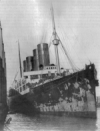 |
140k | Kronprinz Wilhelm as she rests at a New York pier after a 1902 crossing. The paint is worn from her bow plates by the speed of her passage Photo courtesy of Shaum collection from "Great Liners at War" by Stephen Harding |
Robert Hurst | |
 |
249k | Postcard with German postmark of 5 August 1906 and Wilmington, Delaware postmark 14 August 1906 | Tommy Trampp | |
 |
99k | Colored postcard, featuring a photograph of SS Kronprinz Wilhelm taken prior to 1914. The postcard was published by Alb. Rosenthal, Bremen, Germany. Collection of Paul F. Wangerin, 1975. U.S. Navy photo NH 97667-KN |
Naval Historical Center | |
 |
75k | Kronprinz Wilhelm sometime after making good her 1914 escape from probable internment in New York. Note that her well known Norddeutsche Lloyd colors have been hidden beneath a coat of dull sea grey paint. This change, added to the erratic course and high speed the ship maintained, allowed her to make for the rendezvous with SMS Karlsruhe unobserved except by a lone British steamer Photo courtesy of Shaum collection from "Great Liners at War" by Stephen Harding |
Robert Hurst | |
 |
92k | Kronprinz Wilhelm, in a U.S. port, circa April 1915. The ship still carries her guns and flies the German Naval Ensign Photographed by Fisher Donation of Charles R Haberlein, Jr., 2007 Naval Historical Center photo NH 105387 |
||
 |
94k | Interned at Norfolk, Virginia, circa April 1915. She still flies the German naval ensign and carries her guns. The original photograph is printed on post card ("AZO") stock, and was mailed from USS Wyoming (Battleship No. 32) on 30 May (1915 ?) Donation of Charles R. Haberlein Jr., 2008 Naval History and Heritage Command photo NH 105901 |
||
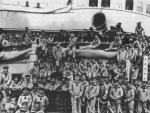 |
152k | Crewmen obviously relieved to be safely interned in a still-neutral port, member's of Kronprinz Wilhelm's crew pose for a group photo soon after the ship's arrival in Virginia National Archives photo from "Great Liners at War" by Stephen Harding |
||
 |
252k | c. 1917 Norfolk Naval Shipyard, Portsmouth, VA Kronprinz Wilhelm moored outboard of Prinz Eitel Friedrich interned at Portsmouth Navy Yard prior to moving to Philadelphia Photo from the Norfolk, Va Public Library website |
Mike Mohl | |
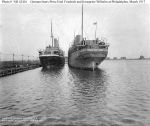 |
110k | Kronprinz Wilhelm and Prinz Eitel Friedrich (left) interned at the Philadelphia Navy Yard, Pennsylvania, on 26 March 1917, shortly before they were seized by the United States. They are still flying the German flag, and German guns are visible on Prinz Eitel Friedrich's stern. During 1917-19, these ships respectively served as USS Von Steuben (ID 3017) and USS DeKalb (ID 3010) U.S. Navy photo NH 42416 |
Naval Historical Center | |
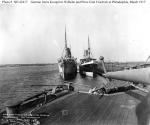 |
104k | Prinz Eitel Friedrich and Kronprinz Wilhelm (left) interned at the Philadelphia Navy Yard, Pennsylvania, on 26 March 1917, shortly before they were seized by the United States. Photographed from on board USS Salem U.S. Navy photo NH 42417 |
||
 |
91k | German Passenger Liner Kronprinz Wilhelm interned at the Philadelphia Navy Yard, Pennsylvania, on 26 March 1917, shortly before she was seized by the United States. Visible on her opposite side are the masts and funnels of the interned liner Prinz Eitel Friedrich Photographed by Replogle. U.S. Navy photo NH 42420 |
||
 |
96k | Prinz Eitel Friedrich and Kronprinz Wilhelm (left) interned at the Philadelphia Navy Yard, Pennsylvania, prior to the U.S. entry into World War I. They are still flying German flags. A U.S. Navy target raft is at right. Courtesy of Paul H. Silverstone, 1983. U.S. Navy photo NH 94986 |
||
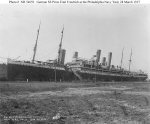 |
118k | Prinz Eitel Friedrich interned at the Philadelphia Navy Yard, Pennsylvania, on 28 March 1917. Behind her is the liner Kronprinz Wilhelm. U.S. Navy photo NH 54659 |
||
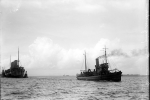 |
83k | SMS Kronprinz Wilhelm in April, 1917 under tow after have being interned in the United States Library of Congress photos LC-H261- 6383 and LC-H261- 6389 |
Mike Green | |
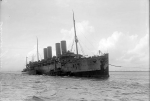 |
91k | |||
| USS Von Steuben (ID 3017) |
||||
 |
90k | Von Steuben shown in drydock following her 9 June 1917 commissioning. The tired and somewhat battered liner entered a Philadelphia Navy Yard drydock for a comprehensive overhaul and fitting out as a trooper. Her starboard screw dwarfs men working on it and the surrounding hull plates Naval History and Heritage Command photo from "Great Liners at War" by Stephen Harding |
Robert Hurst | |
 |
85k | In Brest harbor, France, during World War I. The silhouette of a destroyer, with a large wave at its bow to indicate speed, is painted on her hull side as a camouflage measure. Collection of Peter K. Connelly. Courtesy of William H. Davis, 1967. U.S. Navy photo NH 64965 |
Naval Historical Center | |
 |
199k | Starboard broadside view of the USS Von Steuben during WWI, showing her 'destroyer' painted camouflage scheme. The scheme even was completed with a bow wave. | Mike Green | |
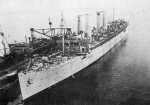 |
150k | . | ||
 |
49k | Photographed during World War I. Her odd camouflage scheme is a destroyer silhouette painted on her side. Courtesy of Jack Howland, 1987. U.S. Navy photo NH 101626 |
Naval Historical Center | |
 |
332k | Photo from "A History Of The Transport Service: Adventures And Experiences Of United States Transports And Cruisers in the World War, by Vice Admiral Albert Gleaves, USN, Published by George H. Doran Company, New York" | Robert Hurst | |
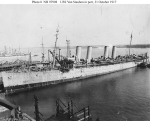 |
109k | In port, 31 October 1917. USS Iowa (Battleship # 4) is behind her. U.S. Navy photo NH 97998 |
Naval Historical Center | |
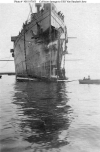 |
123k | Showing damage to the ship's bow, received in a 9 November 1917 collision with USS Agamemnon (ID 3004). The original image is printed on post card ("AZO") stock Donation of Dr. Mark Kulikowski, 2010. Naval History and Heritage Command photo NH 107053 from Shipscribe.com |
Robert Hurst | |
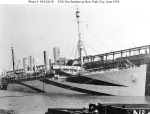 |
98k | Alongside a pier at New York City, 28 June 1918. U.S. Navy photo NH 42418 |
Naval Historical Center | |
 |
71k | Photograph taken circa 1917-18. The image is heavily retouched, with most of the camouflage scheme on the ship painted onto the print. There is no other evidence that this camouflage pattern was actually employed on Von Steuben. U.S. Navy photo NH 279 |
||
 |
91k | At anchor, circa late 1917 or early 1918. The original card bears a hand-written inscription "3-14-19", which may be the date that the original owner was on Von Steuben. It is not the date of the Photograph, as the configuration of the ship's masts, and the presence of guns, strongly indicates that it was taken about a year earlier. Donation of Charles R Haberlein, Jr., 2007 Naval Historical Center photo NH 105069 |
Robert Hurst | |
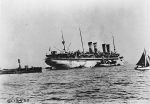 |
130k | c. May 1918 Arriving at Brest, France with American troops Imperial War Museum American First World War Official Exchange Collection, photo No. © IWM (Q 58283) |
Mike Green | |
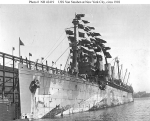 |
125k | At New York City, circa 1918-19, decorated with signal flags for a parade of New York's 27th Division. U.S. Navy photo NH 42419 |
Naval Historical Center | |
 |
75k | In New York Harbor in 1919, probably upon arrival, while returning troops from France Photographed by Enrique Muller. Donation of Larry Speaks, 2001. U.S. Navy photo NH 97668 |
||
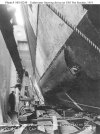 |
128k | Showing underwater listening device, with cap removed, fitted to the ship's hull side just aft of the port bow. Photographed in dry dock at the New York Navy Yard, 25 February 1919 Naval History and Heritage Command photo NH 42249 from Shipscribe.com |
Robert Hurst | |
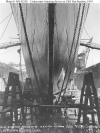 |
132k | A view looking aft from just forward of the bow, while the ship was in dry dock at the New York Navy Yard, 26 February 1919. Blisters for a recently-fitted underwater listening device are visible on both sides, low on the hull just aft of the bow. Also seen are paravane chains (possibly called "Burney Gear") running from the deck down to a fitting at the base of the stem Naval History and Heritage Command photo NH 42250 from Shipscribe.com |
||
 |
168k | A view of the port hull side, just aft of the bow, showing a recently-fitted underwater listening device. Photographed while the ship was in dry dock at the New York Navy Yard, 26 February 1919. Note paravane chains (possibly called "Burney Gear") running from the deck down to a fitting at the base of the stem Naval History and Heritage Command photo NH 42251 from Shipscribe.com |
||
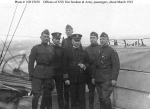 |
83k | The ship's Commanding Officer, Captain Cyrus R. Miller, (center) with his Executive Officer, Commander John W. Wilcox, Jr., and four Army officers, while at sea en route across the Atlantic Ocean to the United States, circa March 1919. Captain Miller states that the Colonel at right was "Commanding a homeward bound Ohio Regiment of Infantry. Afterwards National Commander of the American Legion." However, he does not provide the Colonel's name (Probably Colonel Frederick W. Galbraith Jr., commander of the 147th Infantry Regiment of the 37th Division, formerly the First Infantry Regiment of the Ohio National Guard. Elected in 1920 as the second National Commander of the American Legion) Courtesy of the Naval Historical Foundation. Collection of Captain Cyrus R. Miller. Naval History and Heritage Command photo NH 97670 from Shipscribe.com |
||
 |
148k | Arriving at New York on 1 September 1919, bringing home from France soldiers of the First Division Headquarters; Seventh Field Artillery; First Machine Gun Battalion; First Ammunition Train; Ambulance Companies Two, Three and Twelve; and Field Hospital Number Twelve. Assisting Von Steuban are a U.S. Army tug (far right) and the tug Jennie S. Wade (right center foreground). Panoramic Photograph by Head-Mayberry, 488 Seventh Avenue, New York City Donation of Ione J. Musall Ladd, 2007, from the collection of her father, William Edward Musall, who served in Von Steuban during the World War I era Naval Historical Center photo NH 105396 |
||
 |
276k | Underway in New York Harbor, 1919. Panoramic photograph by the National Photo Service, Inc., New York Courtesy of the Naval Historical Foundation. Collection of Admiral Frederick J. Horne Naval Historical Center photo NH 105322 |
||
 |
48k | c. November 1919 Von Steuben (at right) underway her mangled stem clearly visible. limps toward France under threatening skies following the collision with Agamemnon (center); Mount Vernon is at left. The damage was partially repaired in Brest and she was able to set out for Philadelphia under her own power for more complete repairs Naval History and Heritage Command photo from "Great Liners at War" by Stephen Harding |
||
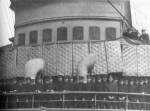 |
105k | Von Steuben's officers gathered for a group portrait near the end of the war. Her commander, Captain Cyrus R. Miller, is in left center, with binoculars. Naval History and Heritage Command photo from "Great Liners at War" by Stephen Harding |
||
| Commanding Officers | ||
| 01 | Kapitänleutnant Paul Wolfgang Thierfelder - Died 19 May 1941 in Norway with the rank of Fregattenkapitän (Commander) | 5 August 1914 - 11 April 1915 |
| Commanding Officers | ||
| 01 | LT Charles Herbert Bullock, USN - Retired as Commander | 9 June 1917 |
| 02 | CAPT Cyrus R. Miller, USN - Awarded the Navy Cross (1918) Retired as Captain | 1918 - 17 May 1919 |
| 03 | CAPT Frederick Joseph Horne, USN - USNA Class of 1899 Awarded the Navy Cross (1919) and the Navy Distinguished Service Medal (1942) - Retired as Admiral | 17 May 1919 - 13 October 1919 |
|
|
The proximity of the British cruiser forced the two German warships to cast off hastily and speed away in different directions. Kronprinz Wilhelm headed north for a time, then steered west and southwest, and she finally steadied up on a course generally east toward the Azores. She reached her destination on 17 August and rendezvoused with the German steamer SS Walhalla off St. Miguel Island. During the following four days, she coaled from Walhalla during the days and the two ships steamed on a southerly course during the nights. After completing the coaling and provisioning operation, the newly commissioned commerce raider learned from German representatives at Las Palmas in the Canary Islands that no further coal would be available in the neighborhood of the Azores and the Canaries. Consequently, her commanding officer decided to head for the Brazilian coast where he hoped to find sources of coal more friendly to Germany or at least a greater choice of neutral ports in which to intern his ship if she should find herself unable to replenish her supplies from captured ships.
During the voyage to the Azores and thence to the South American coast, Kronprinz Wilhelm had to avoid contact with all shipping since she was not ready to embark upon her mission raiding Allied commerce. The guns had to be emplaced and a target for gunnery practice constructed. The crew, mostly reservists and civilians, received a crash course in their duties in a warship and in general naval discipline. A prize crew was selected and trained in the techniques of boarding prizes, inspecting cargo and ship's papers, and in using explosive charges to sink captured ships. Finally, all members of the crew were outfitted in some semblance of a naval uniform.
The crew worked at a feverish pace in order to be ready; and, by the time Kronprinz Wilhelm met Karlsrnhe's tender SS Asuncion near Rocas Reef north of Cape San Roque on 3 September, preparations were nearly complete. And none too soon either for, at 2030 the following evening, the auxiliary cruiser encountered the British steamer SS Indian Prince. The merchantman stopped without the raider's firing a shot. Heavy seas, however, postponed the boarding until shortly after 0600 the following morning. The prize crew found a cargo composed largely of contraband; but, before sinking the ship, Thierfelder wanted to salvage as much of her supplies and fuel as he could, principally the latter. Continued heavy seas precluded the transfer until the afternoon of 8 September. Indian Prince's crew and passengers were brought over to Kronprinz Wilhelm at around 1400, and the two ships moved alongside each other immediately thereafter. Coaling started and continued throughout the night of 8 and 9 September. The following morning, the German prize crew detonated three explosive charges which sank Indian Prince. Kronprinz Wilhelm then headed south to rendezvous with several German
supply ships.
Coal, more than any other factor, proved to be the key to the success of Kronprinz Wilhelm's cruise. The hope of finding that commodity had brought her to the coast of South America, and her success in locating sources of it kept her there. Initially, she replenished from German steamers sent out of South American ports specifically for that purpose. In fact, she spent the next month coaling from four such auxiliaries before she even contacted her next victim. That event occurred on 7 October, when she hailed the British steamer SS La Correntina well off the Brazilian coast in about the same latitude as Rio de Janeiro. The next day, the raider went alongside the captured ship to seize the prize's coal and cargo of frozen meat before sinking her. During the operation, she also improved her martial appearance, though not her actual military capability, when she took La Correntina's two ammunitionless 12 cm. guns and their splinter shields Later, the raider mounted the additional guns aft and they were used for gun drills and to fire warning shots with modified, blank salute cartridges. She continued coaling and provisioning operations from La Correntina until 11 October when bad weather forced a postponement. On the 14th, she resumed the transfer of fuel but broke off again when she intercepted a wireless message indicating that her captive's sister ship SS La Rosarina had departed Montevideo two days earlier and would soon pass nearby. The prize crew placed the usual three explosive charges, and La Correntina sank that same day.
During the ensuing five months, Kronprinz Wilhelm cruised the waters off the coast of Brazil and Argentina. Her success in finding ships laden with coal and supplies combined with her luck and skill in evading British cruisers enabled the raider to capture 15 ships. Of that number, she sank 13 for sure; another she damaged severely by ramming, and it probably sank later. The remaining ship served as transportation into port for what had become an unbearable number of detainees on board after her 12th capture.
Late in March of 1915, the auxiliary cruiser headed north to rendezvous with another German supply ship at the equator. She arrived at the meeting point on the morning of the 28th and cruised in the neighborhood all day. That evening, she sighted a steamer in company with two warships, undoubtedly British, 20 miles distant. Though Kronprinz Wilhelm did not know it at the time, she had just witnessed the capture of her supply ship, SS Macedonia, by two British cruisers. The raider steamed around in the general vicinity for several days, but the passage of each succeeding day further diminished her prospects of a successful rendezvous. Finally, a dwindling coal supply and an alarming increase in the sick list forced Kronprinz Wilhelm to make for the nearest neutral port. Early in the morning of 11 April, she stopped off Cape Henry, Va., and took on a pilot. At 1012 that morning, she dropped anchor off Newport News, Va., and ended her 72-day cruise during which she steamed 37,666 miles and destroyed just under 66,000 tons of Allied shipping.
Though interned, Kronprinz Wilhelm had not quite ended her wartime career. After she interned herself, Kronprinz Wilhelm was moved to Philadelphia. On 6 April 1917, the United States declared war upon the German Empire. That same day, the Collector of the Port of Philadelphia seized the former German raider in the name of the United States. On 22 May, President Wilson issued the executive order which empowered the Navy to take possession of the ship and to begin to repair her. On 9 June 1917, Kronprinz Wilhelm was renamed Von Steuben and commissioned in the United States Navy at Philadelphia, Lt. Charles H. Bullock in command.
Von Steuben began her Navy career as an auxiliary cruiser. Through the summer of 1917, her crew and workers at the Philadelphia Navy Yard prepared her to resume that role against her former masters. However, since the Allied and Associated Powers already maintained virtual control of the seas, their need for that type of ship was minimal. Accordingly, on 21 September, the Office of the Chief of Naval Operations telegraphed an order to the Commandant, Philadelphia Navy Yard, to assign her to transport duty upon completion of repairs to meet a more pressing need, the transportation of troops and supplies to Europe. The ship completed preparations by 29 September and put to sea that same day for her first voyage. During the next four weeks, she remained close to American shores, visiting Hampton Roads and New York in addition to Philadelphia.
On 31 October, she stood out of New York for her first transatlantic voyage under the American flag with 1,223 troops and passengers bound for Brest, France. At about 0605 on the morning of 9 November, Von Steuben received some damage when Agamemnon another troop ship, collided with her during a zigzag. Both ships lost men overboard, and a few received injuries. In addition, two of her 5-inch guns and one of her 3-inch guns were damaged. Though her bow was opened to the sea, Von Steuben maintained 12 knots while the damage control party made repairs. The ship continued on with the convoy and arrived in Brest three days later. She disembarked passengers and unloaded cargo between 14 and 19 November but she did not depart until the 28th.
On her way back to the United States, Von Steuben had to stop over at Halifax, Nova Scotia. At about 0914 on the morning of 6 December, she was about 40 miles from Halifax when lookouts spied a great flame and a high column of smoke in the direction of the port. Visual contact was followed rapidly by the concussion from the explosion of a French ammunition ship, Mont Blanc, in Halifax harbor. Von Steuben learned the facts when she entered the harbor at about 1430 that afternoon. A portion of the city had been devastated by the explosion and the fire which followed. She responded to the emergency by landing officers and men to patrol the city and assist in rescue efforts. The transport remained at Halifax until 10 December and then continued her voyage back to Philadelphia where she arrived on the 13th.
After debarking her passengers, Von Steuben got underway from Philadelphia again on 15 December. She coaled at Newport News on the 16th and remained there until the 20th when she returned to sea, bound for Guantanamo Bay, Cuba, where she disembarked marines. On 27 December, she got underway for the Canal Zone. The ship transited the canal on 29 December and entered the drydock at Balboa that afternoon. Over the next three weeks, she received repairs of the damage to her bow. On 20 January 1918 the ship floated out of the dock and then retransite] the canal. After coaling at Colon, she departed the Canal Zone and headed back to the east coast. From 28 to 31 January, Von Steuben stopped at Newport News where she took on two new 5-inch guns and a 3-inch gun to replace those damaged in the collision with Agamemnon. On 1 February, she returned to Philadelphia to resume duty transporting troops to France.
On 10 February, Von Steuben stood down the Delaware River with another convoy. She reached her destination, Brest, without incident on the 24th, unloaded her troops and cargo, and set out on the return voyage five days later. At about 1620 on 5 March, a lookout spotted an object to port which resembled a submarine periscope. The alarm brought gun crews scurrying to their action stations, and they opened fire immediately. Before anyone realized that they were firing upon an innocuous piece of flotsam a tragic accident occurred. The shell from one of her 5-inch guns exploded immediately upon leaving the barrel, and fragments struck three sailors. One died instantly and the other two succumbed to their wounds later that night. Von Steuben coaled at Bermuda on 12 and 13 March and arrived at Norfolk on the 16th. After repairs and coaling, she moved on to Philadelphia to load troops and cargo for her third voyage to France.
Her next two voyages to France and back were uneventful, as was the New York-to-Brest leg of the following one. However, on the return voyage, she encountered a U-boat. At about 1230 on the afternoon of 18 June, one of her lookouts reported wreckage ahead. As she steamed closer, seven small boats under sail came into sight on the port bow about five miles away. Von Steuben began a zigzag approach to pick up what appeared to be boatloads of survivors from a sunken Allied ship. About 20 minutes later, her lookouts reported the wake of a torpedo approaching her bow from abaft the port beam. The gun crews manned their stations and began firing at the torpedo while the commanding officer ordered the wheel hard to starboard and all engines full astern in an effort to avoid the missile. Meanwhile, some of the gunners had shifted their attention to what they thought to be the periscope of U-151, the source of the torpedo bearing down upon Von Steuben. The ship's efforts to slow down and turn away from the torpedo were successful. It passed a few yards ahead of the ship, and Von Steuben delivered a desultory depth-charge barrage which subjected the submarine to a severe shaking.
The real losers in that brief, but sharp, exchange were the survivors of the British steamer Dwinsk adrift in those seven small boats. U-151 had sunk their ship earlier and remained in the area to use them as decoys for other Allied ships such as Von Steuben. The possibility that they were simply decoys and that other submarines might be lurking about forced the ship to continue on without further investigation. That decision was further reinforced by the fact that the boats appeared empty. Credit for this must go to Dwinsk's master who ordered his people to lie low in their craft so that other Allied ships would not be drawn into the waiting U-boat's trap. Fortunately, he and his men were saved eventually.
Von Steuben arrived in New York on 20 June and began preparations for another voyage to France. On the 29th, she embarked troops for passage to Europe and the next day stood out of New York harbor and formed up with a convoy for the Atlantic crossing. At about noon on the third day out, a fire broke out in the forward cargo hold of Henderson (Transport No. 1). As the blaze grew in intensity, the transfer of the troops embarked became a necessary precaution, and Von Steuben approached the burning ship. Silhouetted by the flames, she would have made a perfect target for any U-boat in the vicinity, but she worked throughout the night and, by morning, had succeeded in embarking Henderson's more than 2,000 troops. Henderson came about and made it safely back to the United States, while Von Steuben completed a somewhat cramped voyage at Brest on 9 July. Three days later, she headed back across the Atlantic with civilians and wounded soldiers returning to the United States after service in Europe. After a peaceful voyage, the transport reached New York on 21 July.
After a short repair period in late July and early August, the ship resumed duty transporting troops to Europe. Between late August and the armistice on 11 November, Von Steuben made three more round-trip voyages carrying troops to France and returning the sick and wounded to the United States. Though all three were peaceful passages by wartime standards, they were not uneventful. On the return voyage from the first of the three, she weathered a severe hurricane during which three of her complement were washed overboard and lost at sea, while several others received injuries. During the New York-to-Brest leg of the second, the influenza epidemic of 1918 struck the 2,700 troops she had embarked and resulted in 400 stretcher cases and 34 deaths.
Von Steuben returned to New York from her ninth wartime voyage on 8 November. On the 10th, she began repairs at the Morse Dry Dock & Repair Co., Brooklyn, N.Y. The next day, Germany signed the armistice which ended hostilities. The former commerce raider completed repairs on 2 March 1919 and put to sea to begin bringing troops home from France. She continued to serve the Navy until 13 October 1919 when she was decommissioned and turned over to the United States Shipping Board (USSB). Her name was struck from the Navy list on 14 October 1919; but, for almost five years, the ship continued to serve the United States under the auspices of the USSB, first as Baron Von Steuben and, after 1921, simply as Von Steuben again. Her name disappeared from mercantile records after 1923.
| Back To The Main photo Index | Back to the Identification Numbered Vessel (ID) photo Index |
| Comments, Suggestions, E-mail Webmaster |
|
This page created by Joseph M. Radigan and maintained by David Wright |